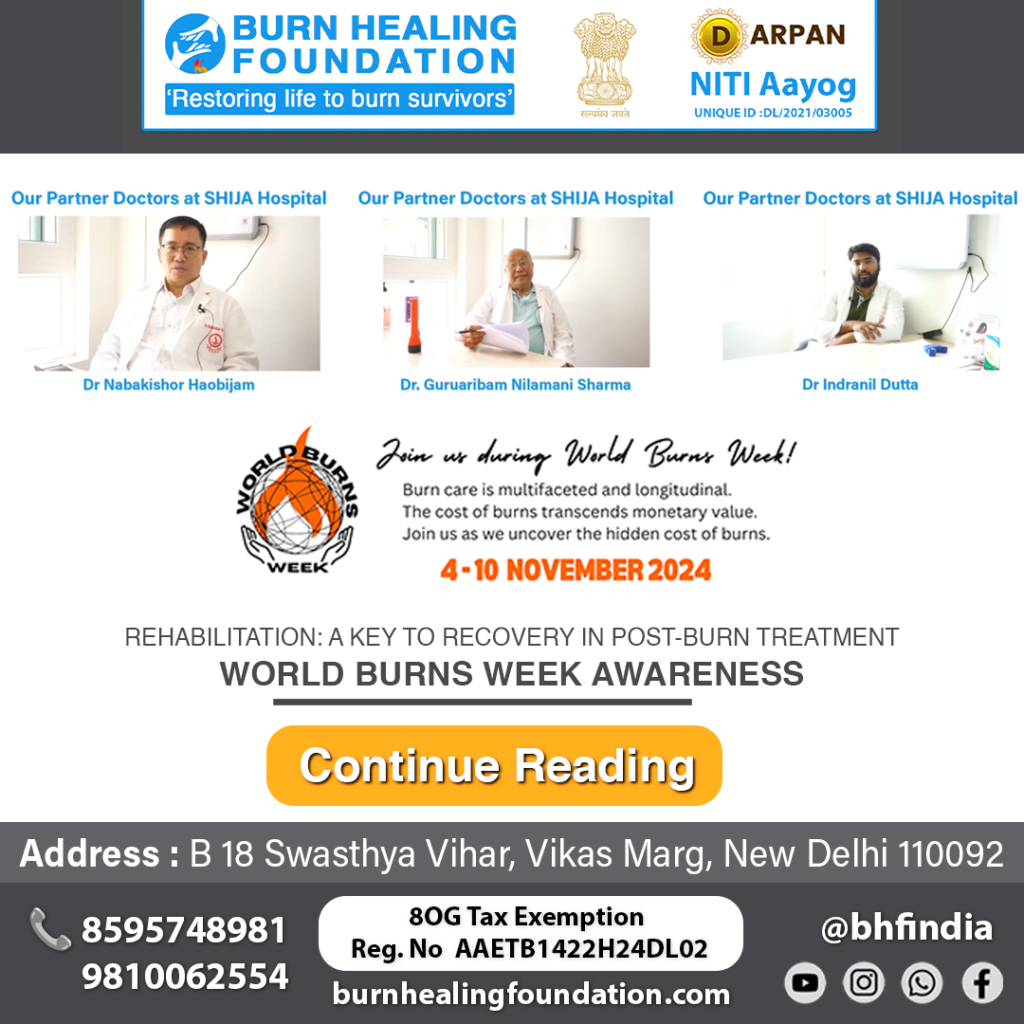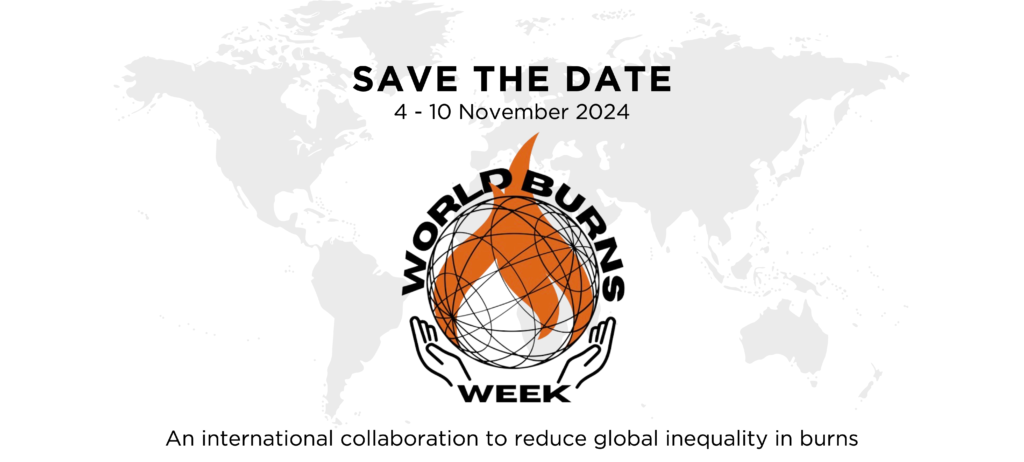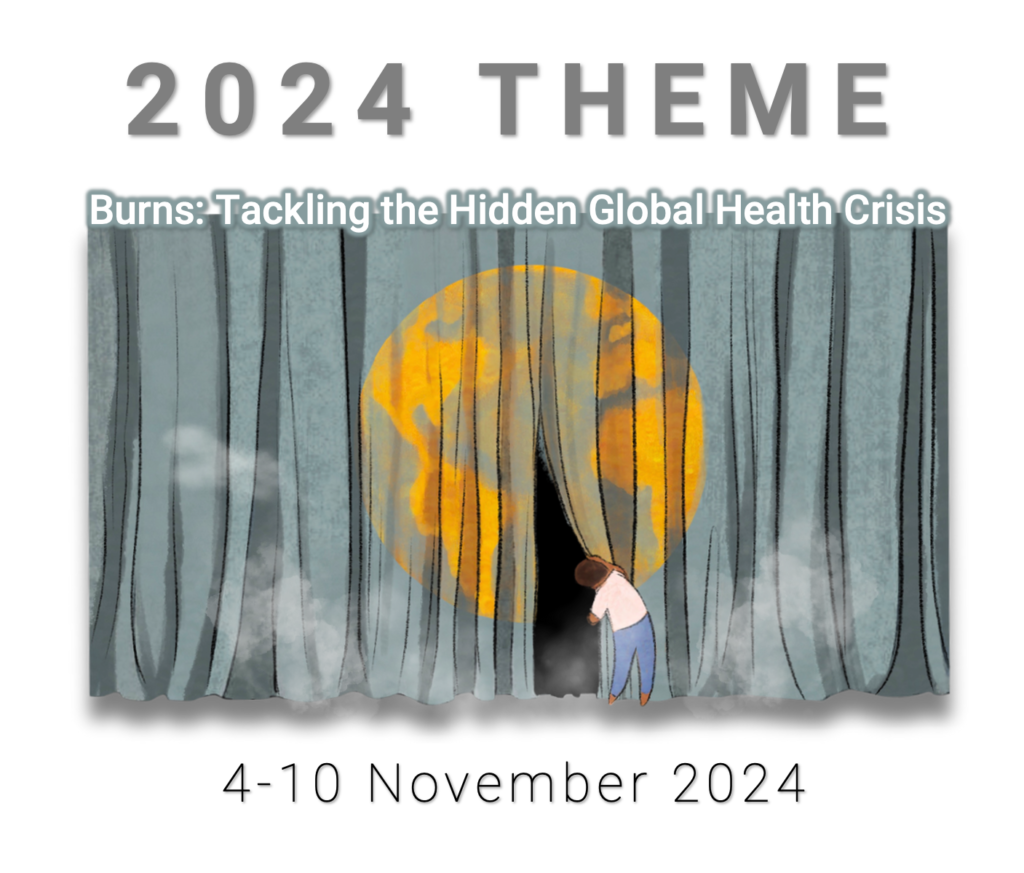Disclaimer: Under our editor, Dr Umar Farooq Baba, our committed hospital partner, Shija Hospitals, Imphal, Manipur, doctors share their message for supporting the World Burns Week social media campaign. Burn Healing Foundation shares the message.
Burn injuries are among the most traumatic experiences a person can endure, often leaving survivors with long-term or lifelong physical and emotional challenges. India, known as the “Burn Capital” of the world, faces a significant burden of burn injuries, rendering access to comprehensive post-burn care formidable. Rehabilitation plays a pivotal role in regaining physical function, rebuilding emotional well-being, and reintegrating into society.
At Shija Hospitals & Research Institute (SHRI), a committed partner of the Burn Healing Foundation (BHF) since 2022, the Burn Healing Scheme has already changed the lives of many burn survivors, offering reconstructive surgery and rehabilitation support. Led by Dr Palin Khundongbam, an expert team of plastic and reconstructive surgeons at the hospital ensures that patients receive comprehensive care—going beyond surgery to provide rehabilitation tailored to each patient’s needs.
The Complex Nature of Burn Injuries and Postburn Contractures
Burn injuries often lead to contractures—scars that tighten and restrict movement, impairing daily function. These contractures can be debilitating, especially when they affect critical areas such as the limbs, perineum, or face. In the case of the face, in addition to being the aesthetic disaster, it can critically affect the functional capabilities of the victim, such as ectropion of eyelids (leading to epiphora, conceal ulcers, opacities, and diminished vision), microstomia, ectropion of the lower lip with continuous drooling of saliva, and so on. In the limbs, there may be difficulties in meeting their daily needs of hygiene, self-care, eating, and ambulating. Children are particularly vulnerable, as contractures can impede timely growth and development, underscoring the need for prompt and effective treatment.
Recent cases at Shija hospitals illustrate the complexity of post-burn contractures. One case involved a child with contractures of the right hand with a syndactyly of all four fingers. In another case, contractures were limiting the movements of the thumb, wrist, and forearm. Both patients underwent surgical correction of deformities under the Burn Healing Scheme. In these cases, comprehensive rehabilitation remains key for restoring mobility and ensuring a desirable functional outcome.
The Role of Rehabilitation in Post-Burn Management Protocols
Rehabilitation is pivotal in post-burn treatment strategy, complementing surgery to help patients regain strength, mobility, and independence. It involves physical and occupational therapy, as well as psychological support, to restore form and function; this indirectly boosts confidence and motivates the patient for further refinements.
Holy Grail
Now what are the primary objectives of post-burn rehabilitation? Though these look so simple and easy to achieve, there is an arduous road ahead; it needs a lot of dedication, perseverance, and self-motivation. But these can be well realized in a determined person. Broadly, the objectives revolve around:
- Restoring Functionality: Burns often affect joints and muscles, restricting movement. Physical therapy helps improve flexibility, strength, and range of motion, enabling patients to resume daily activities.
- Scar Reduction Manoeuvres: Scar reduction therapies and techniques, including the use of pressure garments, massage therapy, and silicone gels/silicone gel sheets, are employed to minimize scarring and prevent re-contractures.
- Emotional Support: Burn survivors frequently face emotional trauma, lower self-esteem, dwindling self-confidence, and social stigma. Psychological support is far more a necessity than is realized. It helps them rebuild confidence and adjust to life after injury, like in preburn times.
- Social Reintegration: Survivors, especially from underprivileged backgrounds, often face barriers to reintegration into society due to physical deformities or disabilities. Rehabilitation programs focus on restoring independence and may include vocational training to assist with employment. Burn survivors are required to undergo job retraining so that they can start some earning. Here, we would like to emphasize that our law states that no establishment shall dispense with or reduce in rank an employee who acquires a disability during his service, and if the employee who has acquired disability is not suitable for the post he was holding, he could be shifted to some other post with the same pay scale and service benefits. In addition, in case it is not possible to adjust him/her against any post, he/she may be kept on a supernumerary post until a suitable post is available or he/she attains the age of superannuation, whichever is earlier. No promotion shall be denied to a person merely on the grounds of his/her disability. Thus, be assured that the law of our land ensures both social as well as vocational security for all, including the burn survivors.
The Healing Partner

The combined efforts of Shija Hospitals and the Burn Healing Foundation (BHF) have been transformative in improving the lives of burn survivors. Founded by Dr. Rajeev B. Ahuja, BHF works to provide reconstructive surgery, financial assistance, and social rehabilitation to survivors, particularly those from underserved communities. Through this collaboration, burn survivors receive holistic care that bridges the gap between medical treatment and the social support they need to recover.
At Shija Hospitals, the skilled team of plastic and reconstructive surgeons (Dr Guruaribam Nilamani Sharma, Dr Nabakishor Haobijam, Dr Michael Laitonjam and Dr Indranil Dutta) perform life-changing surgeries for burn survivors. Through these collective efforts, they remain committed to provide patient-centred care that ensures that burn survivors have access to the best possible treatment and the chance for a fruitful life.
World Burns Week 2024: Raising Awareness of a Hidden Crisis
As World Burns Week (November 4-10, 2024) approaches, the global theme, “Tackling the Hidden Global Health Crisis,” draws attention to the millions of burn survivors who often go unnoticed within healthcare systems, particularly in low-resource settings. Burn injuries represent a neglected public health issue, requiring urgent attention.
This year, Shija Hospitals & Research Institute, in collaboration with the Burn Healing Foundation, aims to raise awareness about the critical role rehabilitation plays in post-burn management. With access to medical care, reconstructive surgery, and targeted rehabilitation, burn survivors can overcome their physical limitations and lead fulfilling lives.
A Call for Action
Burn injuries leave lasting scars, not just physically but emotionally and socially as well. Survivors often face significant challenges that can leave them with a feeling of isolation. By supporting initiatives like the Burn Healing Foundation and its partnerships with hospitals, we can alleviate the suffering of burn survivors. Together, we can restore not only their physical function but also their dignity and hope.
As we mark World Burns Week, let us join hands to create a future where no burn survivor feels isolated, dejected, or disheartened. Every step we take and every life we touch brings us closer to a world where healing is possible for all.
“The greatest glory in living lies not in never falling, but in rising every time we fall.”
Nelson Mandela
Burn Healing Foundation is thankful to the team at Shijia Hospital for being a committed partner in restoring lives and endorsing the cause with active participation by helping us build awareness on social media.







